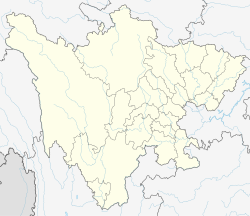ซานซิงตุย
ซานซิงตุย (จีน: 三星堆; พินอิน: Sānxīngduī; แปลตรงตัว: "เนินสามดาว") เป็นแหล่งโบราณคดีและวัฒนธรรมยุคสำริดขนาดใหญ่ ปัจจุบันอยู่ในอาณาเขตนครระดับอำเภอกว่างฮั่น มณฑลเสฉวน ประเทศจีน ส่วนใหญ่ขุดพบในปี 1986[1] หลังการค้นพบอย่างคร่าว ๆ ครั้งแรกในปี 1927[2] โบราณวัตถุที่ขุดพบเมื่อนำไปตรวจวัดอายุคาร์บอน พบอายุอยู่ที่ราว 1200-1100 ปีก่อนคริสต์กาล[3]
三星堆 | |
 ศีรษะสำริดและหน้ากากทองคำเปลวจากซานซิงตุย | |
| ที่ตั้ง | ก่วงฮั่น, Deyang |
|---|---|
| ภูมิภาค | มณฑลเสฉวน |
| พิกัด | 30°59′35″N 104°12′00″E / 30.993°N 104.200°E |
| ความเป็นมา | |
| วัฒนธรรม | บ่าวตุน ซานซิงตุย |
การค้นพบที่ซานซิงตุย แถบลุ่มน้ำสาขาของแม่น้ำแยงซี, แหล่งโบราณคดีต้าหยางโจว (อำเภอซินกั้น แถบลุ่มแม่น้ำกั้น มณฑลเจียงซี) และการค้นพบทางโบราณคดีอื่น ๆ ในพื้นที่ตอนใต้ของจีนสร้างข้อโต้แย้งต่อวาทกรรมดั้งเดิมว่าด้วยอารยธรรมของจีนเผยแพร่จากจงหยวนไปตามแม่น้ำเหลือง รวมถึงเริ่มทำให้เกิดแนวคิดทางโบราณคดีที่ว่า "ศูนย์กลางอารยธรรมจำนวนมากล้วนมีส่วนร่วมกันเป็นต้นตอของอารยธรรมจีน"[4][5]
ปัจจุบันแหล่งโบราณคดีซานซิงตุยได้รับการขึ้นทะเบียนเป็นแหล่งมรดกโลกขั้นเบื้องต้นของยูเนสโก[6]
อ้างอิง
แก้- ↑ Mystery of Ancient Chinese Civilization's Disappearance Explained
- ↑ Xu, Jay (2011). "Lithic Artifacts from Yueliangwan: Research Notes on an Early Discovery at the Sanxingduiu Site". ใน Jerome Silbergeld; Dora C. Y. Ching; Judith G. Smith; Alfreda Merck (บ.ก.). Bridges to Heaven: Essays on East Asian Art in Honor of Professor Wen C. Fong, Volume I. Princeton, NJ: Princeton University Press. ISBN 978-0-691-15298-1.
- ↑ Sage, Steven F. (1992). Ancient Sichuan and the unification of China. Albany: State University of New York Press. p. 16. ISBN 0791410374.
- ↑ Michael Loewe, Edward L. Shaughness (13 March 1999). The Cambridge History of Ancient China: From the Origins of Civilization to. Cambridge University Press. p. 135. ISBN 0-521-47030-7.
- ↑ Jessica Rawson. "New discoveries from the early dynasties". Times Higher Education. สืบค้นเมื่อ 3 October 2013.
- ↑ "Archaeological Sites of the Ancient Shu State: Site at Jinsha and Joint Tombs of Boat- shaped Coffins in Chengdu City, Sichuan Province; Site of Sanxingdui in Guanghan City, Sichuan Province 29C.BC-5C.BC". UNESCO (ภาษาอังกฤษ). สืบค้นเมื่อ 23 February 2018.
บรรณานุกรม
แก้- Bagley, Robert, ed. 2001. Ancient Sichuan: Treasures from a Lost Civilization. Princeton, NJ: Seattle Art Museum and Princeton University Press. ISBN 0-691-08851-9
- Carr, Michael. 2007. "The Shi 'Corpse/Personator' Ceremony in Early China," in Marcel Kujisten, ed., Reflections on the Dawn of Consciousness: Julian Jaynes's Bicameral Mind Theory Revisited, Julian Jaynes Society, 343–416.
- Liu Yang and Edmund Capon, eds. 2000. Masks of Mystery: Ancient Chinese Bronzes from Sanxingdui. Sydney: Art Gallery of New South Wales. ISBN 0-7347-6316-6
- Paper, Jordan D. 1995. The Spirits Are Drunk: Comparative Approaches to Chinese Religion. State University of New York Press.
- Xu, Jay. 2001. "Bronze at Sanxingdui," in Robert Bagley, ed., Ancient Sichuan: Treasures from a Lost Civilization, Seattle Art Museum and Princeton University Press, 59–152.
- Yinke, Deng; Martha Avery; Yue Pan (2001). History of China. 五洲传播出版社. p. 171. ISBN 7-5085-1098-4.
- Sanxingdui Museum; Wu Weixi; Zhu Yarong (2006). The Sanxingdui site: mystical mask on ancient Shu Kingdom. 五洲传播出版社. p. 134. ISBN 7-5085-0852-1.
แหล่งข้อมูลอื่น
แก้- More About the Finds at Sanxingdui เก็บถาวร 2013-02-15 ที่ เวย์แบ็กแมชชีน, National Gallery of Art
- Treasures from a Lost Civilization: Ancient Chinese Art from Sichuan, Seattle Art Museum
- Riddle from the Ancient Past: The Mysteries of Sanxingdui เก็บถาวร 2021-01-23 ที่ เวย์แบ็กแมชชีน, Taiwan Panorama
- Sanxingdui mask relics record traces of Bronze Age เก็บถาวร 2008-10-13 ที่ เวย์แบ็กแมชชีน, Shanghai Star
